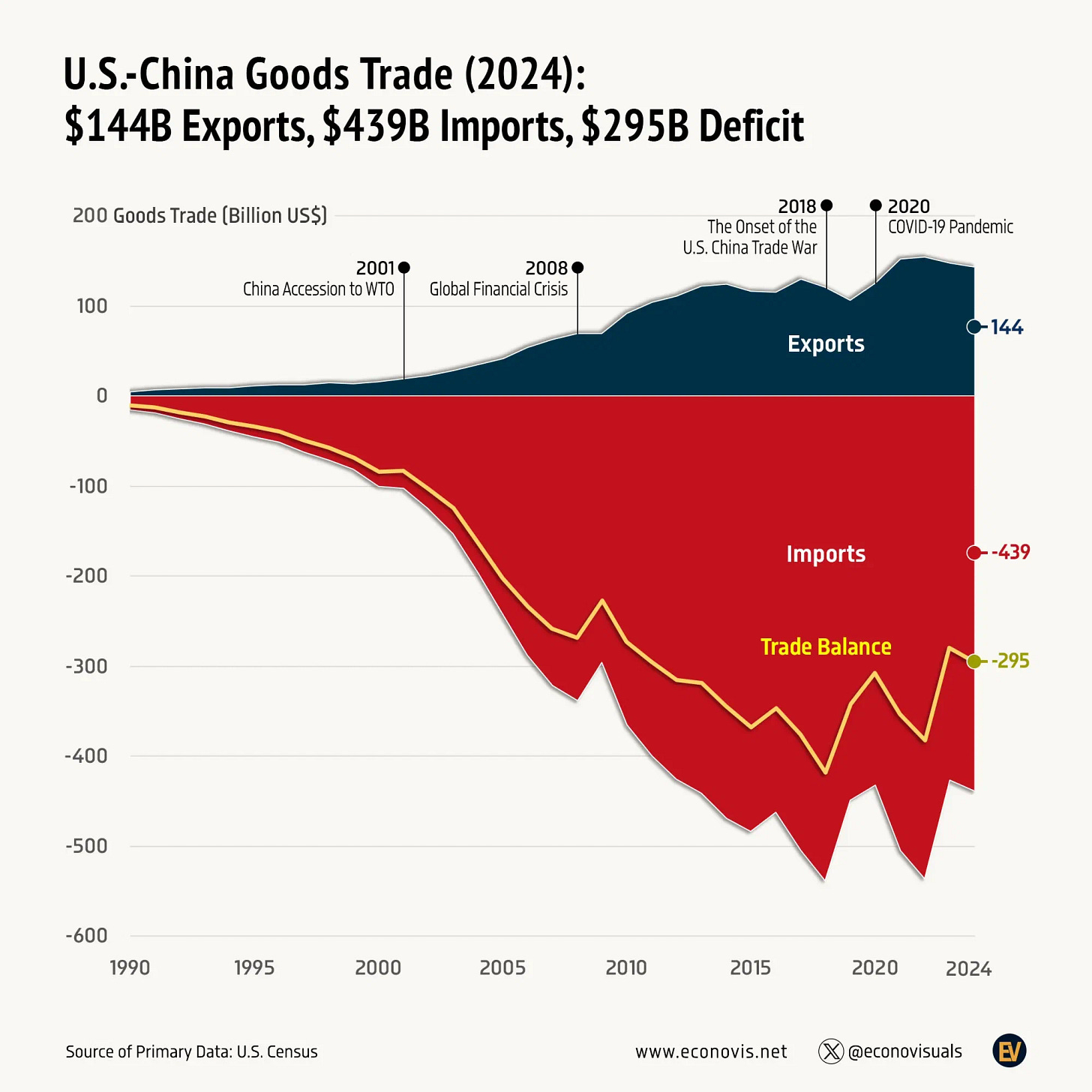Critics claim President Trump’s tariffs will destroy jobs. They are wrong.
In reality, President Trump’s tariffs have the potential to create 15 million new jobs. Many of these jobs will be high-paying manufacturing jobs, with employee benefits—the very sort of jobs that were lost over the last 50 years to offshoring and the “race to the bottom”. How?
Two ways. First, reciprocal tariffs are a carrot. If foreign countries come to the table and lower their own tariffs, then Americans will benefit from freer—and most importantly fair—trade. This will open up new markets worth trillions of dollars to American businesses, supporting millions of jobs back home.
Second, tariffs will level the playing field and protect American workers from foreign labor—who often work in slave-like conditions for next to nothing. This will reshore America’s factories, creating millions of jobs in the process.
Either way, America wins with tariffs.
The Carrot
First thing’s first: America is not an economy.
America is a nation bounded by blood and tradition. The Constitution does not give anyone a right to buy “cheap goods” from China or Bangladesh. The President is obligated to do what is in America’s best interests—even if this prevents smug liberals German cars for French wine.
President Trump is doing just that: he is prioritizing the interests of the American people over and above the interests of any person. Let’s work through the logic—and job creation expectations—of tariffs.
In 2024 America exported $3.19 trillion worth of goods and services. This is in spite of the fact that most of our trade partners impose massive tariffs—as well as other non-monetary barriers to entry such as Byzantine regulations—on American goods. This goes to show just how efficient and competitive America’s industries are.
Nevertheless, the playing field is not level. This results in a massive & chronic global trade deficit.
Let us assume that trading partners see the error of their ways, and reduce their tariffs to reciprocal levels. This will allow American businesses to compete on even terms, and will open foreign markets for America businesses like never before.
If we assume that a 1% reduction in net tariffs results in a 1% increase in trade—which is a reasonable assumption based on current economic models—then America’s exports would increase by $1.6 trillion, bringing total exports up to $4.8 trillion.
Increasing America’s exports would create millions of good paying jobs. The U.S. Census Bureau estimates that every billion of GDP supports between 5,000 and 5,500 jobs. Based on this, these increased exports would support some 8.4 million new jobs. If we assume that only half of our trade partners play ball, we are still looking at over 4 million new jobs.
On top of this, we need to remember that factories function like mines or farms: they are anchor industries upon which service industries depend. As such, they support other jobs that would not exist without them.
Economists have studied this and call it the multiplier effect. Manufacturing has one of the highest multiplier effects of all industries, with each manufacturing job supporting between 1.8 and 2.9 predicate jobs (depending on the type of manufacturing).
But i digress. To sum up: opening new markets to American exports will likely create at least 4 million jobs—probably more because of multiplier effects.
The stick
If our trading partners do not lower their tariffs, who cares? President Trump’s Liberation Day tariffs will create jobs by promoting American industry. Rather than pay tariffs, people will buy American. This has the potential to create another 10 million jobs. How?
Tariffs will create jobs is by reshoring foreign factories to America. For five decades, America has embraced the globalist experiment. In this time, America has lost over 6 million manufacturing jobs—most of them since 2001 when China joined the World Trade Organization.
President Trump’s reciprocal tariffs will end the offshoring vicious cycle, which pits American workers against slave-labor in the Third World—a competition that they cannot possibly win. Instead, foreign producers will reshore their factories and make their products in America. Let’s look at the numbers.
In 2024, America’s net trade deficit was $918 billion—this includes the services surplus. This means that American consumed this much more than we produced. Of course, someone had to make these goods. In this case, mostly China, Mexico, Canada, and the European Union. Accordingly, the trade deficit literally represents the value of America’s offshored economic production—rather than build it in America, we buy it from foreign countries.
If we assume that the tariffs cut the trade deficit in half, to $460 billion (which seems reasonable over the course of President Trump’s term), and if we use the same job-creating assumptions as before, then we can expect the trade deficit reduction to create 2.4 million jobs—primarily manufacturing jobs. If we include the services supported by these, then we can expect Trump’s tariffs to create about 7 million jobs simply by reducing the trade deficit, and reshoring America’s economic production.
In total, and using conservative estimates, President Trump’s reciprocal tariffs have the potential to create 11 million jobs for hardworking Americans, who have been bruised and battered by economic globalism.
In all of this, we need to remember that there will be some pain before the gain. President Trump is realigning the world order, and changing course on 50 years of policy. Just remember that this is not ultimately about economics.
America is a nation, not a market. Tariffs will also liberate America from foreign suppliers, and protect the American Dream for decades—hopefully centuries—to come.





